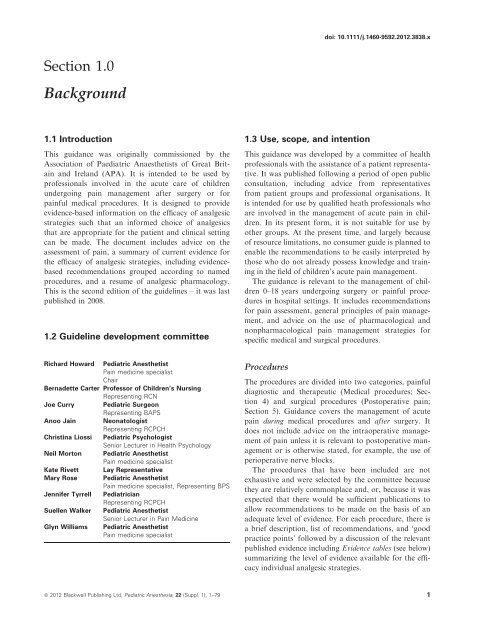Good Practice in Postoperative and Procedural Pain Management ...
Good Practice in Postoperative and Procedural Pain Management ...
Good Practice in Postoperative and Procedural Pain Management ...
You also want an ePaper? Increase the reach of your titles
YUMPU automatically turns print PDFs into web optimized ePapers that Google loves.
doi: 10.1111/j.1460-9592.2012.3838.xSection 1.0Background1.1 IntroductionThis guidance was orig<strong>in</strong>ally commissioned by theAssociation of Paediatric Anaesthetists of Great Brita<strong>in</strong><strong>and</strong> Irel<strong>and</strong> (APA). It is <strong>in</strong>tended to be used byprofessionals <strong>in</strong>volved <strong>in</strong> the acute care of childrenundergo<strong>in</strong>g pa<strong>in</strong> management after surgery or forpa<strong>in</strong>ful medical procedures. It is designed to provideevidence-based <strong>in</strong>formation on the efficacy of analgesicstrategies such that an <strong>in</strong>formed choice of analgesicsthat are appropriate for the patient <strong>and</strong> cl<strong>in</strong>ical sett<strong>in</strong>gcan be made. The document <strong>in</strong>cludes advice on theassessment of pa<strong>in</strong>, a summary of current evidence forthe efficacy of analgesic strategies, <strong>in</strong>clud<strong>in</strong>g evidencebasedrecommendations grouped accord<strong>in</strong>g to namedprocedures, <strong>and</strong> a resume of analgesic pharmacology.This is the second edition of the guidel<strong>in</strong>es – it was lastpublished <strong>in</strong> 2008.1.2 Guidel<strong>in</strong>e development committee1.3 Use, scope, <strong>and</strong> <strong>in</strong>tentionThis guidance was developed by a committee of healthprofessionals with the assistance of a patient representative.It was published follow<strong>in</strong>g a period of open publicconsultation, <strong>in</strong>clud<strong>in</strong>g advice from representativesfrom patient groups <strong>and</strong> professional organisations. Itis <strong>in</strong>tended for use by qualified heath professionals whoare <strong>in</strong>volved <strong>in</strong> the management of acute pa<strong>in</strong> <strong>in</strong> children.In its present form, it is not suitable for use byother groups. At the present time, <strong>and</strong> largely becauseof resource limitations, no consumer guide is planned toenable the recommendations to be easily <strong>in</strong>terpreted bythose who do not already possess knowledge <strong>and</strong> tra<strong>in</strong><strong>in</strong>g<strong>in</strong> the field of children’s acute pa<strong>in</strong> management.The guidance is relevant to the management of children0–18 years undergo<strong>in</strong>g surgery or pa<strong>in</strong>ful procedures<strong>in</strong> hospital sett<strong>in</strong>gs. It <strong>in</strong>cludes recommendationsfor pa<strong>in</strong> assessment, general pr<strong>in</strong>ciples of pa<strong>in</strong> management,<strong>and</strong> advice on the use of pharmacological <strong>and</strong>nonpharmacological pa<strong>in</strong> management strategies forspecific medical <strong>and</strong> surgical procedures.Richard Howard Pediatric AnesthetistPa<strong>in</strong> medic<strong>in</strong>e specialistChairBernadette Carter Professor of Children’s Nurs<strong>in</strong>gRepresent<strong>in</strong>g RCNJoe Curry Pediatric SurgeonRepresent<strong>in</strong>g BAPSAnoo Ja<strong>in</strong> NeonatologistRepresent<strong>in</strong>g RCPCHChrist<strong>in</strong>a Liossi Pediatric PsychologistSenior Lecturer <strong>in</strong> Health PsychologyNeil Morton Pediatric AnesthetistPa<strong>in</strong> medic<strong>in</strong>e specialistKate Rivett Lay RepresentativeMary Rose Pediatric AnesthetistPa<strong>in</strong> medic<strong>in</strong>e specialist, Represent<strong>in</strong>g BPSJennifer Tyrrell PediatricianRepresent<strong>in</strong>g RCPCHSuellen Walker Pediatric AnesthetistSenior Lecturer <strong>in</strong> Pa<strong>in</strong> Medic<strong>in</strong>eGlyn Williams Pediatric AnesthetistPa<strong>in</strong> medic<strong>in</strong>e specialistProceduresThe procedures are divided <strong>in</strong>to two categories, pa<strong>in</strong>fuldiagnostic <strong>and</strong> therapeutic (Medical procedures; Section4) <strong>and</strong> surgical procedures (<strong>Postoperative</strong> pa<strong>in</strong>;Section 5). Guidance covers the management of acutepa<strong>in</strong> dur<strong>in</strong>g medical procedures <strong>and</strong> after surgery. Itdoes not <strong>in</strong>clude advice on the <strong>in</strong>traoperative managementof pa<strong>in</strong> unless it is relevant to postoperative managementor is otherwise stated, for example, the use ofperioperative nerve blocks.The procedures that have been <strong>in</strong>cluded are notexhaustive <strong>and</strong> were selected by the committee becausethey are relatively commonplace <strong>and</strong>, or, because it wasexpected that there would be sufficient publications toallow recommendations to be made on the basis of anadequate level of evidence. For each procedure, there isa brief description, list of recommendations, <strong>and</strong> ‘goodpractice po<strong>in</strong>ts’ followed by a discussion of the relevantpublished evidence <strong>in</strong>clud<strong>in</strong>g Evidence tables (see below)summariz<strong>in</strong>g the level of evidence available for the efficacy<strong>in</strong>dividual analgesic strategies.ª 2012 Blackwell Publish<strong>in</strong>g Ltd, Pediatric Anesthesia, 22 (Suppl. 1), 1–79 1
















